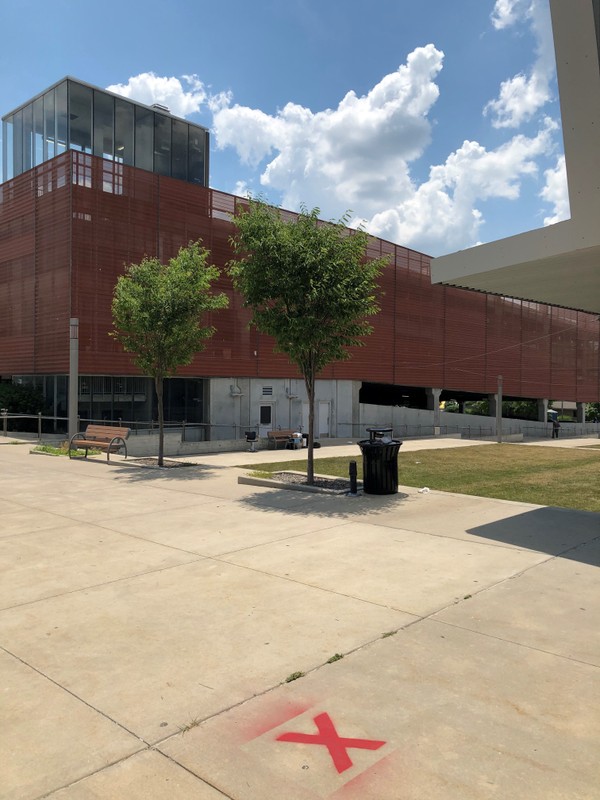Dix Home
Introduction
Text-to-speech Audio
Now home to the downtown library, this was the site of a hotel known as the Johnson House as well as the home of the Ralph and Jetta Dix family in the early 1860s. It was here where Jetta Dix watched Quantrill's men kill her husband, Ralph Dix, and her brother-in-law. Four hours after Jetta was awoken by gunfire and screaming, the raid was over and she and eighty-four other women became widows while her children were among the 250 children in Lawrence who were left fatherless.
Images

Backstory and Context
Text-to-speech Audio
Fifty years after Quantrill's Raid, which occurred before daybreak on August 21, 1863, Jetta Dix discussed what she witnessed at her home, including watching her brother-in-law and husband die. The raid resulted in the deaths of more than 150 men and teenage boys and the destruction of the majority of the town, mainly due to fire.
Seen as a leader by the Confederacy, they commissioned William Quantrill in 1861 as an officer under the Partisan Ranger Act, which authorized the formation of guerrilla military groups. For several months in 1863, Quantrill and his men planned an attack on Lawrence, a hub of abolitionism in Kansas. Indeed, several members of the New England Emigrant Aid Society ostensibly founded Lawrence and actively sought to thwart the westward advancement of slavery. Moreover, Lawrence harbored fugitive slaves, welcomed freed slaves, and stood as the site of the enlistment of Black troops. Lastly, Lawrence was the home of James Lane (an eventual U.S. Senator), who led regiments that burned and looted Osceola and other nearby Missouri communities.
At 5 a.m. on August 21, 1863, with the sun merely peeking above the horizon, yelling and gunfire awakened Jetta Dix. Jetta had come to the U.S. from Ireland as a six-year-old with her father. In 1858, at age 17 or 18, she moved to Lawrence. One year later, she married Ralph, who had come to Lawrence from Connecticut in 1855. Ralph worked as a blacksmith and operated a carriage shop near downtown Lawrence. Jetta, the mother of three young children and a boarding-house operator (third floor of their home), looked out the windows and saw the devastation unfolding. Jetta noticed Governor Charles Robinson's office on fire and then witnessed one of Quantrill's men shooting and killing the owner of the Eldridge House hotel. She saw men on horseback riding up and down the streets, yelling and shooting their pistols and rifles; Quantrill had ordered his men to shoot any man or boy old enough to carry a weapon.
Jetta begged her husband to run away and hide, but Ralph chose to wait, believing he and other Lawrence residents could seek refuge in an arsenal about a block from their home. Ralph Dix also hoped they could arm themselves and fight back. Unfortunately, Dix and the others discovered the town's arsenal was locked, leaving Lawrence residents defenseless.
Meanwhile, Jetta hid her children in a coal shed, watched by their African American nurse, and wandered outside to see what was happening. She saw men jumping from the windows of the nearby Johnson House (hotel), only to be shot as they attempted to run away. Jetta remarked that it felt like guerrillas were coming in every direction, and dead bodies lay in the streets. The horror pushed Jetta to rush home to warn her husband and others to stay inside and hide. Unfortunately, she returned too late. By the time she returned, raiders had already shot her brother-in-law, Frank Dix. Jetta unsuccessfully tried to protect Ralph by standing between William Quantrill's men and her husband. But, Jetta stumbled after tripping on a rock after one of Quantrill's men rode his horse into her, leaving Ralph unguarded and providing an opportunity for the guerrilla soldier to shoot and kill him.
Just four hours after Quantrill and his men began their attack, the town lay in ruins. The raiders burned most of the buildings in Lawrence to the ground, and they killed more than 150 men and boys, resulting in 85 widows and 250 fatherless children (including Jetta and her kids).
Sources
Biles, Jan. "Quantrill's raid: 'Abomination against civilians' Bushwhackers killed about 180 men, boys in Lawrence." The Topeka Capital-Journal. June 10, 2015. cjonline.com. https://www.cjonline.com/news/.
Epps, Kristen. "Quantrill’s Raid on Lawrence" Civil War on the Western Border: The Missouri-Kansas Conflict, 1854-1865. The Kansas City Public Library. Accessed Saturday, February 17, 2024. https://civilwaronthewesternborder.org/encyclopedia/quantrills-raid-lawrence.
Tanner, Beccy. "150 years later, Quantrill's raid on Lawrence still stirs deep emotions – on both sides." The Wichita Eagle. kansas.com. August 26, 2013. https://www.kansas.com/news/local/news-columns-blogs/the-story-of-kansas/article1121021.html.
